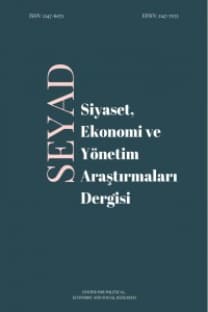The Effect of Informal Economy on the European Debt Crisis
The informal economy poses a problem not only for developing countries today; it also appears to be a growing problem in all advanced countries of the world. This paper empirically investigates whether the size of informal economy has any effect on overindebtedness in the context of Europe. Thus, we attempt to provide empirical evidence that it is not a coincidence that those countries most severely affected from the crisis are also the ones with the highest size of informal economy, such as Greece, Italy, Spain and Portugal. The empirical analysis is based on the official data published by European Statistical Agency and the World Bank. The relationship between the informal economy and indebtedness is examined through GMM model on the panel data of 27 EU countries for the years 1999 through 2007. Findings show that there is a significant relationship between informal economy and indebtedness.
Anahtar Kelimeler:
.
The Effect of Informal Economy on the European Debt Crisis
The informal economy poses a problem not only for developing countries today; it also appears to be a growing problem in all advanced countries of the world. This paper empirically investigates whether the size of informal economy has any effect on overindebtedness in the context of Europe. Thus, we attempt to provide empirical evidence that it is not a coincidence that those countries most severely affected from the crisis are also the ones with the highest size of informal economy, such as Greece, Italy, Spain and Portugal. The empirical analysis is based on the official data published by European Statistical Agency and the World Bank. The relationship between the informal economy and indebtedness is examined through GMM model on the panel data of 27 EU countries for the years 1999 through 2007. Findings show that there is a significant relationship between informal economy and indebtedness
Keywords:
EU Debt Crisis, Informal Economy, Overindebtedness Budget Deficit,
___
- Arellano, M., Bond, S. (1991). “Some Tests Of Specification For Panel Data: Monte Carlo Evidence and an Application to Employment Equations.” Review of Economic Studies, 58, pp: 277-297.
- Baltagi, Badi H. (2005): “Econometric Analysis of Panel Data / p.26” 3rd Edition. England, John Wiley&Sons Ltd.
- Carter, Michale (1984): “Issues In the Hidden Economy A Survey”, Economic Record, Vol 60, pp:209-221
- Feige, Edgar L. (1996): “Overseas Holdings of U.S. Currency and the Underground Economy”, in: Pozo, Susan (ed.): Exploring the Underground Economy. Kalamazoo, Michigan.
- Fiege, E.L. (1986): “Re-examination of Underground Economy in the United States: A Comment on Tanzi,” IMF Staff Papers, Vol.33, Issue:4, December, pp.768-81
- Fiege, E.L. (1990): “Defining and Estimating Underground and Informal Economies: The New Institional Economics Approach,” World Development, Vol.18, No.7.
- Güloğlu, Bülent, Tekin, R.B., (2012), “A Panel Causality Analysis of the Relationship among Research and Development, Innovation, and Economic Growth in High-Income OECD Countries”, Eurasian Economic Review, Vol.2, No.1, 2012 pp. 32-47.
- Holtz-Eakin, D.,W.K. Newey, and H. S. Rosen (1988). “Estimating Vector Autoregressions With Panel Data”. Econometrica 56: 1371–1395. http://www- wds.worldbank.org/external/default/WDSContentServer/IW3P/IB/2010/1 0/14/000158349_20101014160704/Rendered/PDF/WPS5356.pdf
- Ilgın, Yılmaz (1995): “Kayıt Dışı Ekonomi ve Türkiye’deki Boyutları”, Unpublished Masters Thesis, State Planning Organization, Ankara.
- Karagül, Mehmet (1997): “Kayıt Dışı Ekonomi ve Türkiye’de Kayıt Dışı Ekonominin İncelenmesi”, Celal Bayar Üniversitesi İİBF, Yönetim ve Ekonomi Dergisi, Issue 3: pp.185-205
- Kök, Recep, Şapçı, Onur (2006): “Kayıt Dışı Ekonomi ve Türkiye Ekonomisi’ndeki Büyüklüğünün Tahmin Edilmesi”, Turkish Economic Association International Conference on Economics, Ankara, 11-13 September 2006.
- Saraç, Mehmet (2010): “Measuring the Effectiveness of Internal Credit Rating: An Application on a Participation Bank”, International Research Journal of Finance and Economics, Issue 53, pp. 10-118.
- Savaşan, Fatih (2005): “Avrupa Birliği Genişleme Sürecinde Saklı ve Informal Ekonomiler” Arıkan, Harun and Muhsin Kar (editors), Türkiye Avrupa Birliği İlişkileri: Siyasal, Bölgesel ve Ekonomik Boyutlar, Seçkin, 345-376
- Schneider F. (2005): “Shadow Economies of 145 Countries all over the World: Estimation Results over the Period 1999 to 2003” Yaşar University International Conference, Çeşme, 2005
- Schneider, F. (2003): “The Size and Development of the Shadow Economies and Shadow Economy Labor Force of 22 Transition and 21 OECD Countries: What Do We Really Know”, The Informal Economy in the EU Accession Countries, Size, Scope, Trends and Challenges to the Process of EU Enlargement, Boyan Belev (editor), Center for the Study of Democracy, www.csd.bg, 23-62
- Schneider, Fredrich (2000): “Illegal Activities And The Generation of Value Added: Size, Causes And Measurement of Shadow Economies”, Bulletin on Narcotics, No 1/2
- Tanzi, Vito (1983): “The Underground Economy in the United States: Annual Estimates, 1930-80” International Monetary Fund Staff Papers, 3(2), June 1983:283-305
- Tanzi, Vito (1986): “ The Underground Economy in the United States, Reply to comments by Feige, Thomas, and Zilberfarb.” IMF - Staff Papers, 33/ 4, pp. 799-811.
- Tanzi, Vito (1999): “Uses and Abuses of Estimates of the Underground Economy,” The Economic Journal 109/456, pp.338-340
- Temel, A. Şimşek, A. Yazıcı, K. (1994): Kayıtdışı ekonomi: Tanımı, Tespit Yöntemleri ve Türk Ekonomisinde Büyüklüğü, The State Planning Organization, Ankara.
- The World Bank (2010): “Shadow Economies All over the World - New Estimates for 162 Countries from 1999 to 2007”, Policy Research Working Paper 5356
- Yetim, Sedat (1999): Türkiye’de Vergi Kaçakçılığı ve Kayıt Dışı Ekonomi, Turkish Banks Association, Istanbul.
- ISSN: 2147-6071
- Yayın Aralığı: Yılda 2 Sayı
- Başlangıç: 2014
- Yayıncı: Politik Ekonomik ve Sosyal Araştırmalar Merkezi
Sayıdaki Diğer Makaleler
Sosyal Devlet Anlayışı Çerçevesinde Türkiye’de Sosyal Koruma Harcamalarının Gelişimi ve Yoksulluk
Sosyal Dışlanma ve Avrupa Birliği Yaklaşımı
Kitap Tanıtımı: Dan Ariely, Akıldışı Ama Öngörülebilir
Türkiye’de Eğitim Harcamaları ve Ekonomik Büyüme Arasındaki İlişki: ARDL Sınır Testi Yaklaşımı
Yahia BOUCHETA, Lakhdar ADOUKA, El Mustapha KCHIRID
İndirgenmiş Nakit Akış ve Göreceli Değerleme Yöntemlerinin Karşılaştırılması
